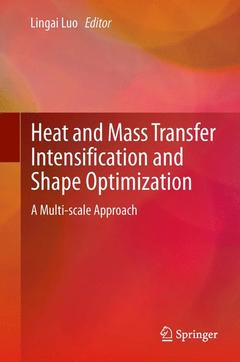Description
Heat and Mass Transfer Intensification and Shape Optimization, 2013
A Multi-scale Approach
Language: English
Subjects for Heat and Mass Transfer Intensification and Shape...:
Publication date: 03-2015
Support: Print on demand
Publication date: 03-2013
180 p. · 15.5x23.5 cm · Hardback
Description
/li>Contents
/li>Biography
/li>Comment
/li>
Is the heat and mass transfer intensification defined as a new paradigm of process engineering, or is it just a common and old idea, renamed and given the current taste? Where might intensification occur? How to achieve intensification? How the shape optimization of thermal and fluidic devices leads to intensified heat and mass transfers? To answer these questions, Heat & Mass Transfer Intensification and Shape Optimization: A Multi-scale Approach clarifies the definition of the intensification by highlighting the potential role of the multi-scale structures, the specific interfacial area, the distribution of driving force, the modes of energy supply and the temporal aspects of processes.
A reflection on the methods of process intensification or heat and mass transfer enhancement in multi-scale structures is provided, including porous media, heat exchangers, fluid distributors, mixers and reactors. A multi-scale approach to achieve intensification and shape optimization is developed and clearly explained.
Providing readers with a tool box of reflections, techniques, methods, supported by literature reviews, Heat & Mass Transfer Intensification and Shape Optimization: A Multi-scale Approach will be a key guide for students, a teaching aid for lecturers and a source of inspiration for future research subjects.
Lingai LUO received her Bachelor’s (1982) and Master’s (1984) degrees in thermal energy engineering from Harbin Institute of Technology, China. She received her Ph.D. degree (1991) in mechanic and thermal engineering from National Polytechnic Institute of Lorraine (INPL), Nancy, France. She worked as assistant professor (1991-1993) at INPL, as associate professor (1993-1996) at University of Nancy I, and at INPL (1996-2003). From 2003 until 2012 she was a professor at University of Savoie, France. She is now senior research director of French National Center for Scientific Research (CNRS).
Prof. Luo’s research covers a wide range of topics in thermal, process and energy engineering and focus on a fundamental strategy based on thermodynamic analysis and centered on the transfer intensification and energy systems optimization. More recently, it concerns firstly the design, fabrication, characterization, simulation and optimization of innovative fluidic, thermal and reactive components, and secondly the development of new thermo-chemical systems and processes for low-grade thermal energy transportation and valorization, and inter-seasonal solar energy storage for their applications in buildings. She proposed a multi-scale approach for optimization of global performance of energy systems and process.
Prof. Luo was the head of laboratory of design optimization and environmental engineering (LOCIE) of CNRS and University of Savoie from 2007 until 2012. She was the cofounder and coordinator of Sino-French Collaboratory for Environmental and Process Engineering (1998-2006) and is the head of Sino-French Laboratory for Sustainable Energy (since 2008) of French CNRS and Chinese Academy of Sciences. She is also an invited professor at 5 Chinese universities/institutions, and Leuphana University at Lüneburg, Germany.




